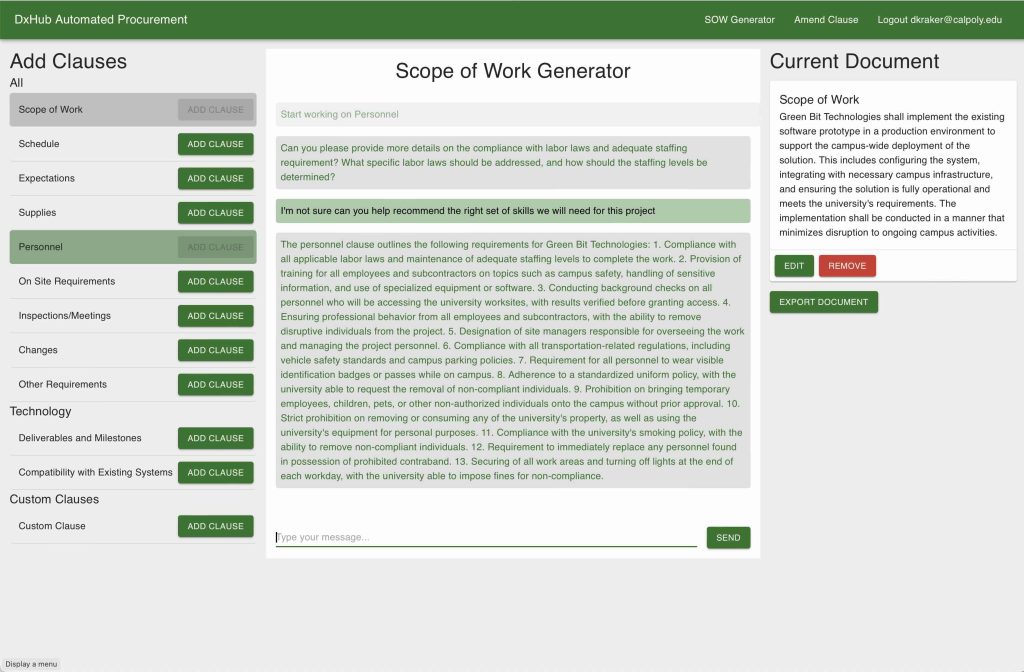Cal Poly experiments with generative AI for drafting a scope of work for campus contracts

Overview
The California Polytechnic State University, San Luis Obispo (Cal Poly) Digital Transformation Hub (DxHub), powered by Amazon Web Services (AWS), has embarked on an innovative collaboration with the university’s Strategic Business Services department to revolutionize the procurement process through the application of Generative AI technology. This initiative aims to streamline and enhance the creation of comprehensive statements of work (SOWs) for university buyers, leveraging the power of artificial intelligence to analyze and learn from exemplary historical documents.
The project, spearheaded by Cal Poly’s Chief Procurement Officer, seeks to address the complex challenges faced by the university’s centralized procurement system. With Procurement Specialists bearing the ultimate responsibility for all purchasing decisions and contract executions, the need for clear, precise, and thorough scopes of work (SOW) is paramount. By harnessing the capabilities of Generative AI, the university aims to empower its procurement team with an intelligent tool that can generate more comprehensive and effective SOWs based on a curated repository of ideal language samples from previous successful procurements.
As this initiative unfolds, it promises to modernize how the university interacts with qualified contractors and suppliers, potentially streamlining the procurement process, and ensuring more consistent and well-developed SOWs are used in RFPs and contracts. The success of this project could have far-reaching implications, serving as a model for other institutions seeking to modernize their procurement practices through the strategic application of AI technologies.
Problem
 Cal Poly’s procurement process occasionally struggles with the large volume of requests to purchase a multitude of goods and services. Total spend during fiscal year 2023/24 was over $190 million. University procurement specialists are expected to be knowledgeable in many commodity areas. The reality is that procurement specialists often need to expand their knowledge in a very short time frame in order to develop a clear and comprehensive SOW. This is needed so that the university does not risk publishing an RFP that includes an incomplete or vague SOW.
Cal Poly’s procurement process occasionally struggles with the large volume of requests to purchase a multitude of goods and services. Total spend during fiscal year 2023/24 was over $190 million. University procurement specialists are expected to be knowledgeable in many commodity areas. The reality is that procurement specialists often need to expand their knowledge in a very short time frame in order to develop a clear and comprehensive SOW. This is needed so that the university does not risk publishing an RFP that includes an incomplete or vague SOW.
Effective SOWs must balance fairness to all parties. This allows all prospective suppliers the opportunity to clearly understand what services are needed, and to compete fairly for Cal Poly’s business.
Procurement specialists can face other challenges, including compliance with CSU Procurement Policies and the California Public Contract Code. Depending on the type of procurement, additional requirements can apply such as liability insurance, bonding, prevailing wages, and licensing. The complexity of these requirements, combined with the university’s diverse procurement needs, can challenge the procurement specialists. Without a standardized, intelligent system for SOW development the procurement workload is increased, which can delay the procurement process.
The challenge is to develop a solution that benefits the procurement team, ensures consistency and compliance across SOWs, and streamlines the procurement process without compromising quality. Generative AI offers a promising avenue to address these complex issues in the world of university procurement.
Innovation in Action
 To address the challenges faced by Cal Poly’s procurement team, the DxHub developed an innovative AI-assisted tool that uses generative AI to assist the human in the loop during the SOW creation process. This cutting-edge solution, named “ScopeBuilder,” focuses on enhancing scope development for contracts, Bids, and RFPs, streamlining the creation of high-quality scopes of work (SOWs).
To address the challenges faced by Cal Poly’s procurement team, the DxHub developed an innovative AI-assisted tool that uses generative AI to assist the human in the loop during the SOW creation process. This cutting-edge solution, named “ScopeBuilder,” focuses on enhancing scope development for contracts, Bids, and RFPs, streamlining the creation of high-quality scopes of work (SOWs).
ScopeBuilder leverages advanced generative AI capabilities to reduce common pain points in the procurement process, such as limited commodity knowledge, vague or unclear work scopes, and lack of clear milestones. The system employs a conversational AI interface that guides users through creating comprehensive SOWs, ensuring that even procurement specialists with limited knowledge of a particular industry can produce detailed and comprehensive documents.
One of the key features of ScopeBuilder is its ability to draft work scopes in real-time, one section at a time based on user input and established best practices. As users interact with the system, it dynamically generates content, drawing from a set of examples from relevant past contracts. This ensures that each SOW is tailored to the specific needs of the procurement while adhering to established industry practices.
ScopeBuilder suggests appropriate milestones and deliverables, helping to structure contracts more effectively and reduce the risk of project delays or misunderstandings. It can generate clauses based on user input and existing templates, automatically formatting the generated content into the proper document structure required by Cal Poly and the CSU system.
One of the most powerful aspects of ScopeBuilder is its ability to work with varying levels of initial information. Whether a user has detailed specifications or only a general idea of what they need, the system adapts its approach accordingly. When necessary, it prompts users for additional information, ensuring that no critical details are overlooked in the work scope development process.
To maintain flexibility and user control, ScopeBuilder also offers options to edit or request changes to the completed document. This feature is an intelligent search and replace feature that is context aware and makes changes in a contextually relevant way.
Technical Solution
The ScopeBuilder application leverages a modern, serverless architecture to ensure scalability, security, and performance. The front-end is built using React, providing a responsive and intuitive experience for procurement specialists. This React application is hosted on Amazon S3, which offers secure, durable, and highly-scalable object storage.
To ensure fast content delivery worldwide, the application utilizes Amazon CloudFront, AWS’s content delivery network (CDN). This not only improves the application’s performance but also helps protect against DDoS attacks. Security is further enhanced through the use of AWS Certificate Manager, which provides SSL/TLS certificates for the application, ensuring all data transmitted between users and the application is encrypted.
The backend of ScopeBuilder is entirely serverless, primarily utilizing AWS Lambda for compute functions. This allows the application to automatically scale based on demand without the need for server management. The core of the AI functionality is powered by Amazon Bedrock, specifically leveraging the Anthropic Claude Sonnet 3.5 model. This advanced language model enables the application to understand and generate human-like text, facilitating the creation of detailed and accurate statements of work.
The architecture ensures that all user data and generated content are processed securely within the AWS ecosystem, maintaining the privacy and confidentiality required for university procurement processes.
Supporting Documents
| Source Code | All of the code and assets developed during the course of creating the prototype. |
About the DxHub
The Cal Poly Digital Transformation Hub (DxHub) is a strategic relationship with Amazon Web Services (AWS) and is the world’s first cloud innovation center supported by AWS on a University campus. The primary goal of the DxHub is to provide students with real-world problem-solving experiences by immersing them in the application of proven innovation methods in combination with the latest technologies to solve important challenges in the public sector. The challenges being addressed cover a wide variety of topics including homelessness, evidence-based policing, digital literacy, virtual cybersecurity laboratories and many others. The DxHub leverages the deep subject matter expertise of government, education, and non-profit organizations to clearly understand the customers affected by public sector challenges and develop solutions that meet the customer needs.

